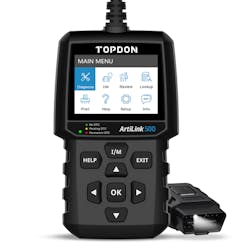Tool Review: TOPDON Artilink500 Code Reader
Q: What types of jobs/repairs did you use this tool for?
A: We often have customers stop in wondering why their “Check Engine” light is on. We will do a quick code scan to give them some peace of mind and help our staff have a basic understanding of the problem in order to prioritize the customer’s appointment. If it is a misfire, we get them in right away. If it is something less crucial, we schedule them at a later time. So, we mainly use the tool for initial scanning when customers come in with a light on. We don’t use it for full diagnostic scanning; for that we use our full-feature scanners.
Q: How did the tool/equipment function as far as saving you time?
A: This code reader is handy for doing a quick scan on a vehicle that has a “Check Engine” light on. It powers up in less than 30 seconds and will connect to the car and read codes within a minute.
Q: How easy was it to use?
A: I would say it is very easy to use for any technician who is used to scanning vehicles for fault codes.
Q: Was there a manual included?
A: There was no manual included, but I really didn’t need one. I plugged it in and it was very intuitive regarding its use. I do think a manual should be included though.
Q: What features did you like?
A: It is very quick and easy to use. You don’t have to select the make or model of vehicle you are working on in order to scan for codes. The tool automatically looks at the different communication protocols and selects the proper protocol in order to scan for codes. I also like that it’s free to update the tool to work with newer vehicles.
Q: Is there any way you could think to improve or add to this tool?
A: There are some vehicles that the tool doesn’t work on. Sometimes the tool would say there were no codes present when the “Check Engine” light was on. Sometimes it would read the code but not give any code description. In both of these situations, I had to get a different scanner to read and interpret the fault codes. This would happen particularly on European imports but also with some domestic vehicles. If the problems could be corrected, that would be a great improvement to this tool.
Q: Have you used a previous version of this tool? If so, what are some new features compared to the old version?
A: I have had basic scanners similar to this one. This one is quicker to boot up and read codes, so I like that.
